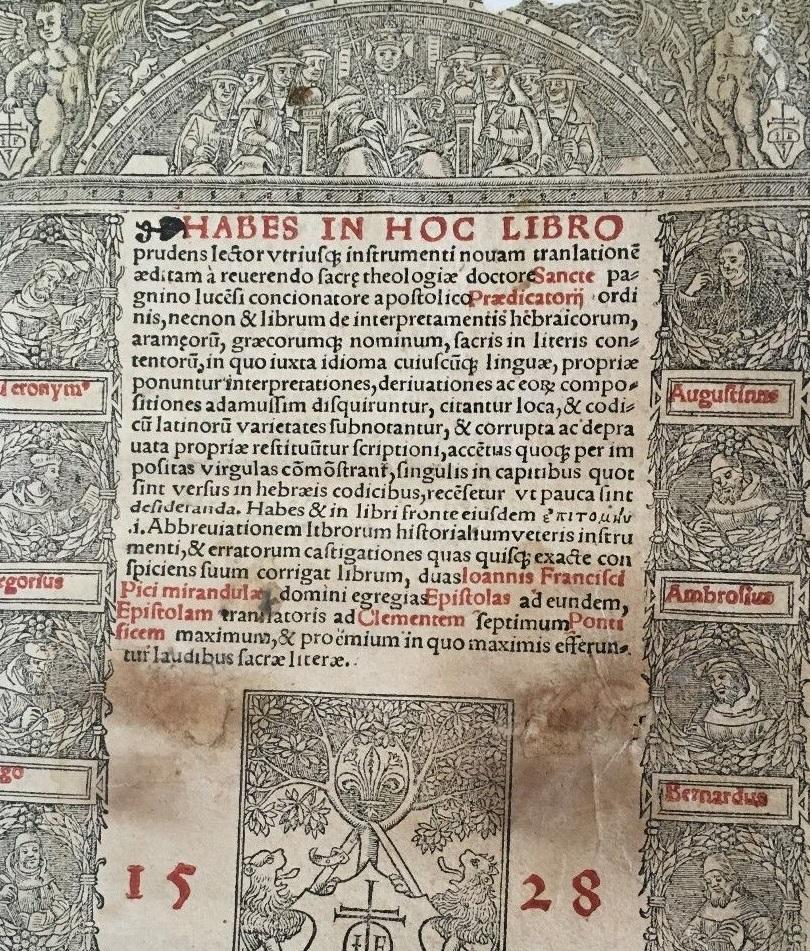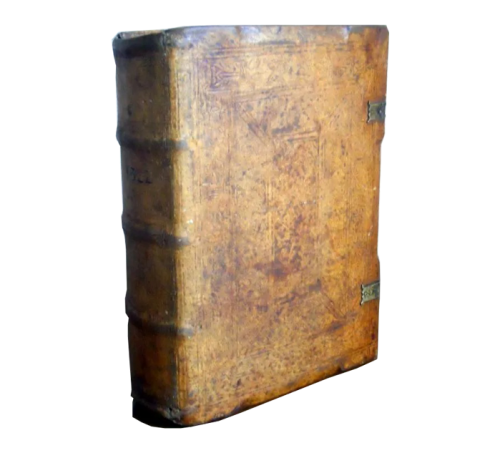Description
First edition of 1528, The Pagnini Bible was the first to divide the biblical text into numbered verses and one of the first revisions of the Latin Vulgate using the original languages. Sante Pagnini was an Italian monk and biblical scholar who eventually settled in Lyon, France. Like other scholars at this time, he became interested in studying the Bible in its original Greek and Hebrew sources. He completed his Latin translation in 1528, dividing his Bible into numbered verses for easier reference. His divisions, however, are different from the system used today, which was developed by Robert Estienne in 1551. Pagnini?s translation of the Old Testament was widely known for its literal reading of the Hebrew and remained popular until the end of the 1500s. Pagnino was born 1470 at Lucca, in Tuscany, central Italy. At sixteen he took the religious habit at San Domenico in Fiesole, where he studied under the direction of Savonarola and other eminent professors.[1] In acquiring the Oriental languages, then cultivated at Florence, he displayed unwonted quicksightedness, ease and penetration. His genius, industry and erudition won him influential friends, among them the Cardinals de’Medici, subsequently popes Leo X and Clement VII. As a sacred orator his zeal and eloquence kept abreast with his erudition and were as fruitful. Summoned to Rome by Leo X, he taught at the recently-opened free school for Oriental languages until his patron’s death (1521). He then spent three years at Avignon and the last seven years of his life at Lyon. Here he was instrumental in establishing a hospital for the plague-stricken, and by his zeal and eloquence, diverted an irruption of Waldensianism and Lutheranism from the city, receiving in acknowledgement the much coveted rights and privileges of citizenship. Here he also was in contact with the polymath and Hebraist Michael Servetus, whom he gave his notes to, and designated him as his heir to the scholarly study of the bible after he would have died. The epitaph of Pagnino, originally adorning his tomb in the Dominican church at Lyon, fixes the date of his death on 24 August 1541, at Lyon, beyond dispute. 24, 5 centimetros 29 hojas sin numerar +1-135 + 1-98 foliadas + 70 sin numerar. A dos columnas, excepto las 29 hojas preliminares y las Epistolas de Sanctes Pagninus, que inicia la tercera parte del volumen, letra redonda iniciales grabadas en madera. Titulos corrientes sin reclamos. Portada Orlada dos tintas, roja y negra. Breve de Adriano Vi (Roma 11 de mayo de 1523) por el cual concede licencia a Sanctes Pagninus, O.P para imprimir como se proponía. Id de Clemente VII (roma, 6 junio 1526) de análogo tener, licencia de la orden de los Predicadores, Bible in Latin, trans. Sanctes Pagninus BIBLIA. HABES IN HOC LIBRO PRUDENS LECTOR VTRIUSQUE INSTRUMENTI NOUAM TRANSLATIONEM AEDITAM À REUERENDO SACRAE THEOLOGIAE DOCTORE, SANCTE PAGNINO LUCENSI PRAEDICATORIJ ORDINIS . LYONS: ANTONIUS DU RY FOR FRANCESCO TURCHI, DOMENICO BERTICINIO AND JACOPO GIUNTA, 29 JANUARY 1527/28 (TITLE-PAGE: 1528) Super-Median quarto (238 × 174 mm). Collation: a-c8 d6 (title with Giunta device, Greek commendatory verse, commendatory letters of Adrian VI, Clement VII, and Gianfrancesco Pico della Mirandola, contents summaries of Old Testament books, prologue); A-Z AA-PP8 (Hebrew Old Testament books, Genesis-Malachi); QQ-XX8 YY4 (Greek Apocrypha: Tobit, Judith, Wisdom, Ecclesiasticus, Baruch, 1-2 Maccabees); a-l8 m10 (New Testament; colophon); n-v8 x6 (Interpretations of Hebrew Names): 554 leaves, PP8 and YY4 blank. Old Testament foliated 1-355; New Testament foliated [1] 2-98. Red and black printing, woodcut title border, woodcut initials. Leaves browned, with soiling, three leaves with strengthened inner margins. Seventeenth-century vellum, red-sprinkled edges. Leaves browned, with soiling, three leaves with strengthened inner margins. First edition of Pagnino.


